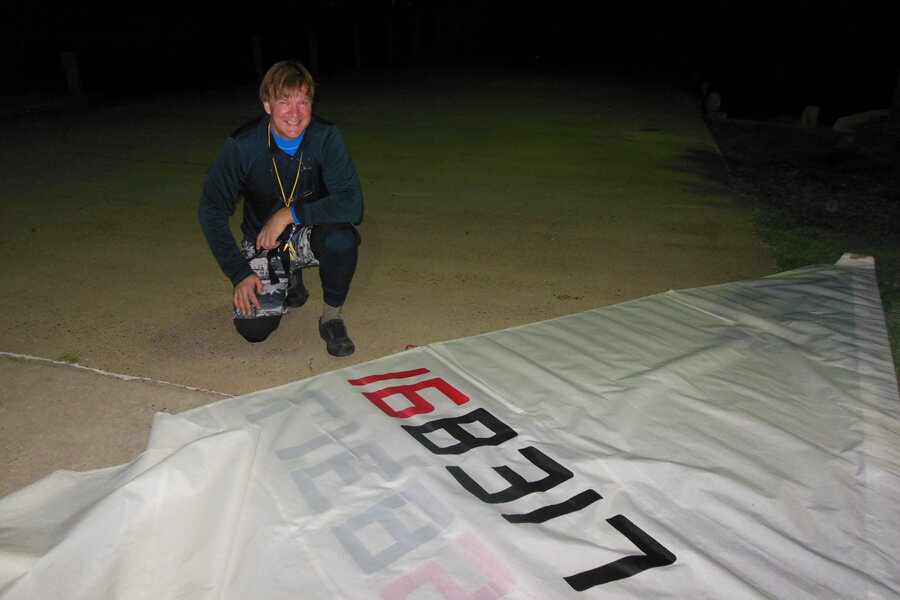What tech would you stake your life on?
Loading...
What technology would you trust your loved-one’s life to?
As my husband, Robert Suhay, 51, attempts to break the Guinness Book World Record for longest distance sailed in a dinghy solo and unaided, I am learning some of the answers to that question in 20/20 hindsight.
Robert launched from the Old Dominion University Sailing Center in Norfolk, Va., on Sunday at 5:08 a.m. for a three-day, 317 nautical mile sail, unassisted by a chase boat. He is sailing up the Chesapeake Bay, past Baltimore, to the mouth of the Sassafras River and back.
Mexican Olympic sailor Tania Elias Calles is the current Guinness Book record holder, having traveled 300 nautical miles back in 2010.
Robert has officially applied to Guinness via its website to be the first to beat Ms. Calles record.
The entire trip will take more than 50 hours with no landfall.
We are not wealthy people. My husband’s attempt is not sponsored. His primary gear, beyond the 14-foot Laser dinghy, is an HTC One Android phone and the free Utter app for voice activated control (to avoid wet hands on technology).
Robert and I are both trying out a Magellan eXplorist 510 GPS unit provided by that company.
He also has a handheld marine radio that he borrowed from a friend, but that is for emergency situations only.
The Utter an offline, voice-controlled, digital personal assistant, which is currently only in a beta version. It’s the poor man’s Siri.
While Utter appears to be working brilliantly since the launch, I have gotten reports from mariners who have sighted Robert Monday that the Android phone got wet, despite the waterproof case, and has been rendered inert.
That means no communication via tweet, text, or the GPS locator chip that our carrier, T-Mobile, could otherwise access to locate my sailing spouse.
After 24 hours passed in total radio silence with no sightings, I chose to go old school and notified the US Coast Guard’s Baltimore unit to ask for a visual confirmation of his whereabouts.
“Even the best technology can fail," says USCG’s Petty Officer Jonathan Silverberg, who has been assisting me in locating Robert. "That’s part of why we’re here.”
Petty Officer Silverberg added, “As long as his GPS keeps him on track, he’s looking good.”
Therefore, it appears that the GPS was the most critical piece of gear because he needs to stay on course so as to both make the record and not become exhausted by getting lost, backtracking, or ending up in areas that would require too much tacking (an exhausting route adjustment or turning maneuver for a small boat sailor).
A good GPS device can mean efficiency of effort, accuracy, critical weather updates, or the lack thereof on a trip such as this.
As tweets and e-mails pour in from all over the country, I realize the piece of gear I should have sent with him was a SPOT GPS tracker that he could tap (much like a Star Trek communicator badge) and ping a satellite with his location.
For $100, I could be much calmer right now because this piece of gear does motion-activated tracking.
The eXplorist 510 World Edition map allows for 2-D or 3-D viewing angles of preloaded maps and nautical or aviation charts. This model surprised me by also having a 3.2 pixel camera that takes photos and video which it geotags. It also has a speaker to record voice memos. This will help confirm the validity of his world record claim for The Guinness Book judges. The eXplorist has both a touch screen and two customizable hard buttons. Robert programmed his to activate the compass and the camera. The unit is powered by two AA batteries lasting ideally up to 16 hours.
This offers one issue for a sailor in the kind of extreme conditions my husband faces by having a battery door that completely detaches.
“If it comes off I can lose it,” Robert said before the trip, frowning at the device.
To help conserve power, there is a “suspend mode” to turn off the device, but maintain GPS tracking. I like this feature because it means he doesn’t have to fiddle with the unit to get it on and off in an effort to conserve power.
Because his phone is dead, that means all images of his trip are now in the hands of his GPS. At the last minute, his overused GoPro camera refused to hold a charge and we ran out of time to obtain a new one.
Because of the utter communications and tracking fails, we are relying on some old-school, human help.
If you live along the Chesapeake Bay and spot a white Laser sailboat with the sail #168317 between today and July 3, please tweet it to #LaserRecord, or make contact via the website I setup to track his quest.








